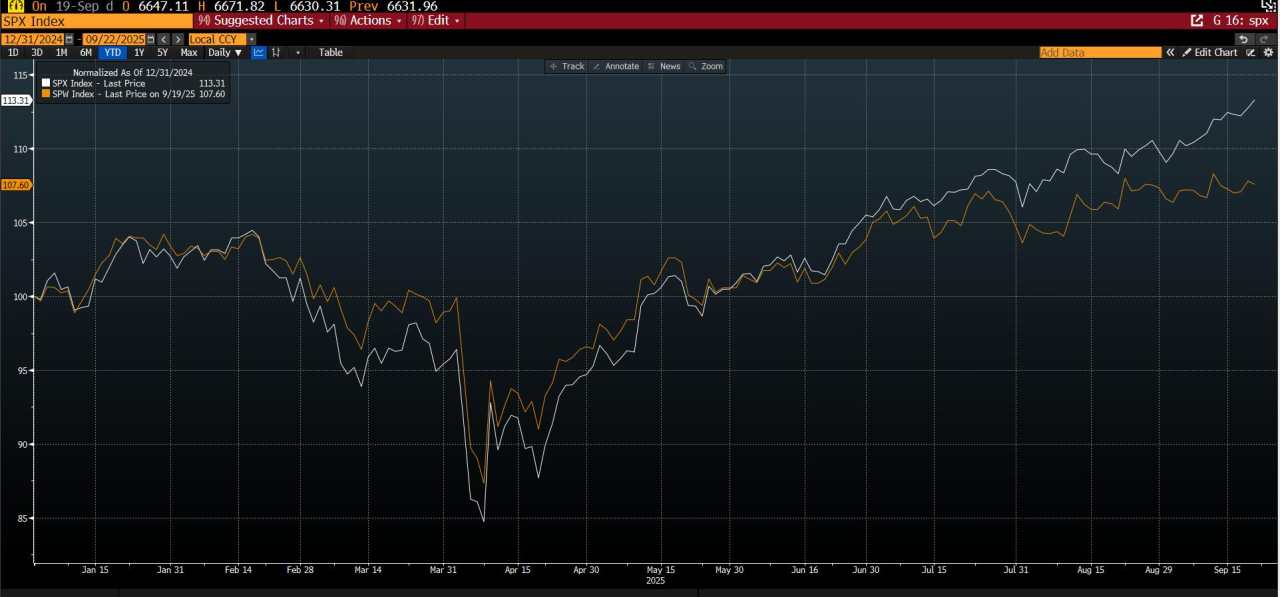- US stocks powered by Fed.
- IPOs surge, as enthusiasm for new issues rises, yet Klarna falls.
- Why concentration risk is not an impediment to US market gains.
- PMI data to give us crucial information as we end Q3.
- The SNB to lay the groundwork for negative rates.
- Powell speech in focus, but Miran’s words are more important for the market.
Stocks are poised to open lower in the US and the UK today, as the risk rally takes a pause, although Japanese stocks jumped at the start of the week as fears about Bank of Japan tightening have eased. With little in the way of economic data releases at the start of the week to determine market direction, the focus could be on two tech developments. Firstly, the handshake between President Trump and Elon Musk at Charlie Kirk’s memorial, and secondly, the news that Larry Ellison, Michael Dell and Lachlan Murdoch are part of the consortium of investors trying to buy TikTok in the US.
Tesla shares rose 15% last week. After tumbling sharply during the public spat between Musk and Trump earlier this year, a newly rekindled friendship could be good for the stock price and the recent rally may advance into this week.
Fed: Happy to cut rates with a good economic backdrop
The key takeaway from last week was that the Federal Reserve is comfortable cutting interest rates in an environment where the US economy is not in recession and inflation is well above the Fed’s 2% target rate. The stage could be set for another leg higher for US stocks as we move towards the fourth quarter: financial conditions are lose, stocks are at record highs and credit spreads are tightening, while more monetary loosening is on the cards. The Fed’s own Dot Plot suggests another two rate cuts this year, and with the changing of the guard at the Fed in the coming months, there could be further loosening in 2026.
US stocks: A powerful winning streak
US stock markets set multiple records last week. The S&P 500 powered to a record high on Friday, the Russel 2000 also made a record intraday high, however, it closed down 0.77%, although US mid cap stocks rose more than 2% on the week, beating the S&P 500’s 1.2% gain. US stocks are on a powerful winning streak: five straight months of gains, since the April low. The S&P 500 is higher by 37%, the Nasdaq 100 is higher by 48% and the Russel is higher by 41%. These are impressive, especially after a slow start to the year for US indices. Another sign of optimism for US indices is a resurgence in IPOs. Initial Public Offerings have surged in recent weeks. 169 companies went public in the US in August, which is more than all IPOs in 2024.
It is not all good news, Klarna, who listed earlier this month, saw its share price fall rapidly on Friday, and its share price is lower by 17% since its IPO. This is partly down to some criticism of its expansion plans, and news that the Klarna CEO is revamping how he controls his stake in the company. Thus, the sell-off may be temporary.
Tech is leading the rally in US stocks. The equal-weighted S&P 500 is struggling to keep pace with the market capitalized index, which is dominated by the tech giants, as you can see in the chart below. The top performing stocks on the S&P 500 so far in September include Tesla, Oracle, Micron Technologies and Intel. In contrast, stocks linked to the consumer are some of the weakest performers, including Lululemon and Dollar Tree.
US concentration risks are overdone
The dominance of tech means that concentration risk is once again building in the US stock market. The Magnificent 7 now make up more than 30% of the entire US index by market capitalization. Nvidia, Google and Microsoft now have a combined value of $11.1 trillion. This is more than a third of the size of the US economy, which is set to grow to more than $30 trillion this year.
Having a top-heavy index is not necessarily problematic, and we do not think that it will stop US stocks from extending gains in the current environment. The top ten stocks in Germany, France, Brazil, South Korea and China constitute more than 50% of their country’s equity indices. Thus, while there is no doubt that the AI theme is a major driver of US stocks right now, the lower concentration of the S&P 500 relative to its peers could make US stocks even more attractive.
Chart 1: S&P 500 and the equal weighted S&P 500

Source: XTB and Bloomberg
All eyes on the UK bond market
Other news that could dominate at the start of this week, is the fallout from the UK’s public sector borrowing figures for August. Borrowing has shot past OBR forecasts in the first 5 months of the fiscal year. Talk of more public sector spending in the UK, including potentially scrapping the 2-child benefit cap, may exacerbate pressure on UK long-end yields at the start of this week. With the Bank of England edging further away from a rate cut, the UK Gilt market was one of the weakest global bond markets last week, especially at the long end of the curve. The pound also lost ground vs. the USD and was down nearly 1% over the week, although it is clawing back some losses this morning.
The dollar managed to gain ground last week, as it received some support from rising US Treasury yields. Although the Fed signaled lower interest rates in future, Treasuries lost ground and yields rose, after falling sharply in the weeks leading up to the FOMC meeting. However, we think that this was a knee jerk reaction, and yields will not rise as sharply in the coming days.
Trump’s H-1B visa plans could hit Amazon
It is a quiet start to the week on Monday. We will be watching to see if there is any fallout from the Trump administration’s plan to raise the H-1B visa application fee to $100,000. The new policy is now in effect, and it may impact the mega cap tech stocks who employ thousands of people on H-1B visas. Amazon has the highest number, closely followed by Microsoft, Meta, Apple and Google. Although these companies have the money to afford the vias, other sectors who also rely on H-1B visas may struggle with future recruitment, for example the health care and education sectors.
Gold surges to fresh record
The gold price has surged to a fresh record on Monday, and is above $3,700 per ounce, as fears continue to build about monetary policy loosening in the US as the economy remains resilient. The gold price’s inexorable rise and multiple record highs, means that technical indicators like the MACD is looking overbought. However, as the world’s oldest inflation hedge and with the Fed poised to embark on another monetary policy loosening cycle, gold is likely to remain well supported in the coming months.
Ahead this week, the focus will be on the latest PMI readings and a raft of Fed speakers this week. Below, we look at the key events you should follow in the week ahead.
1. PMI data
This will give us another timely update into how the world’s private sector firms are coping with US tariffs. PMI survey data will come out on Tuesday. These will provide the final monthly reading for Q3 2025. The European index is expected to edge up slightly in September, and the composite index is expected to come in at 51.1. There are lots of concerns about the German economy, however, analysts expect Germany’s composite PMI to pick up to 50.7 this month, although the service sector is expected to remain mired in negative territory.
In the UK, there could be more bad news on the growth front. The composite PMI is expected to plunge to 53.0, from 53.5 in August. The manufacturing sector is expected to remain in negative territory at 46.7. If this is confirmed, then it would be 12 consecutive months of negative readings. The service sector is also expected to retreat to 53.5 from 54.2. The deterioration in the service sector is especially concerning for the UK’s growth outlook, since we are predominantly a service based economy. A cautious consumer, and a rising tax burden are bad for business.
The US index is also expected to moderate slightly last month. Although tariffs might be weighing on some sectors of the US economy, Fed rate cuts could soothe the path for future US economic growth. Overall, these PMI reports could show a widening gap between the US and European growth outlooks.
2. Swiss National Bank decision
This is the first SNB meeting since the US imposed a 39% tariff rate on Switzerland. The Swiss franc is the top performing currency in the G10 FX space so far in September, and it is higher than 13% YTD vs. the USD. This is likely to keep the SNB concerned about deflation risks.
With the SNB likely to remain on hold for the long term, their communication will be key. The SNB is likely to focus on deflation risks at this meeting, and could lay the path for a move to negative rates in the coming months. Thus, Thursday’s meeting could take the edge off the Swiss franc for the short term.
3. Fed speakers
There are 17 Fed speakers to digest in the coming days. This includes Fed chair Jerome Powell, who speaks about the economic outlook on Tuesday. This will be closely watched, to see if the Fed chair signals his support for continued rate cuts, including into 2026. However, the most interesting Fed speaker could be its newest member Stephen Miran who is speaking just before Powell at the Economic Club of New York.
Miran voted for a 50bp rate cut from the Fed last week, and there is a good chance that he is also the Fed member who expects another 100bps of cuts this year, as expressed on last week’s Dot Plot. Investors will want to get a sense of why he wanted such drastic rate cuts when the economy is holding up well and when inflation is running ahead of the Fed’s target rate of 2%. His speech will also be analyzed to see what it can tell us about future Trump Fed picks, and what this may mean for the future of Fed policy.
作者:Kathleen Brooks,文章来源FXStreet,版权归原作者所有,如有侵权请联系本人删除。
风险提示:本文所述仅代表作者个人观点,不代表 Followme 的官方立场。Followme 不对内容的准确性、完整性或可靠性作出任何保证,对于基于该内容所采取的任何行为,不承担任何责任,除非另有书面明确说明。


加载失败()